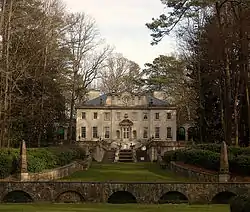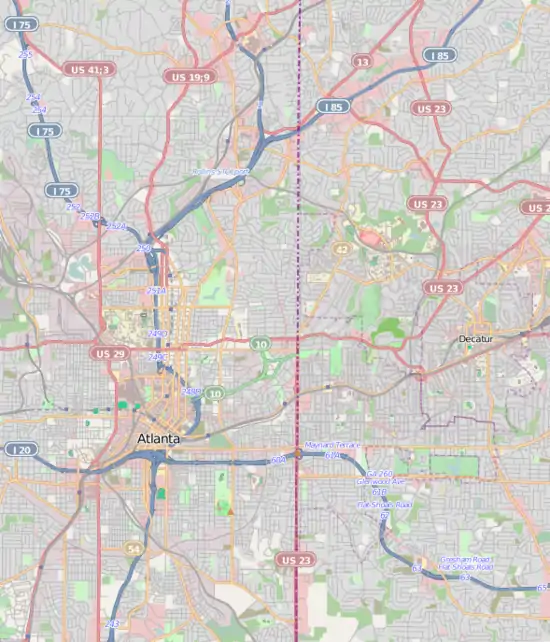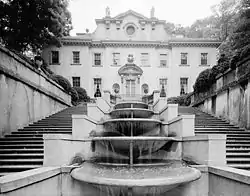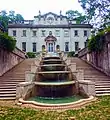Swan House (Atlanta)
Swan House is located on the grounds of Atlanta History Center’s main campus and was built in 1928 for Edward and Emily Inman in Atlanta, Georgia. In recent years, the house is celebrated as a set in the Hunger Games movies.
Swan House | |
 Front of Swan House and Yard | |
 | |
| Location | Atlanta, Georgia |
|---|---|
| Coordinates | 33°50′25″N 84°23′17″W |
| Built | 1928 |
| Architect | Schutze, Philip T. |
| Architectural style | Late 19th and 20th Century Revivals |
| NRHP reference No. | 77000434 |
| Significant dates | |
| Added to NRHP | September 13, 1977[1] |
| Designated ALB | October 14, 1989 |
Architecture and gardens
Designed by architect Philip T. Shutze, the Swan House design combined Renaissance revival styles with a Classical approach on the main facade. The rear facade is less formal, and is sited at the top of a small hill with terraced gardens and a fountain cascading down the hillside. A recurring motif are sculpted or painted swans throughout the house and grounds.
Classical architectural details, such as the columns and broken pediments, elements borrowed from the exteriors of classical buildings, are prevalent throughout the interior.[2] The interior architectural detailing, however, was designed to complement the varied furnishings and objects in the Inman’s' collections. Interior treatments of Swan House are eclectic. While each room conveys the aura of a distinct eighteenth-century style, in each there is a free adaptation of the style in the architectural detail, and the imposition of twentieth-century taste in the furnishings.
Shutze described the Swan House gardens design saying, “…the landscape was done with the Italian garden in England in mind.” He took the best of baroque Italy and merged it with English style into a modern home of the early twentieth century. From the grand, sweeping lawn to the private boxwood garden, Shutze’s plan takes you from drama to intimacy.[3]
History
Edward Inman received his early education in Atlanta and New Jersey, and later attended Princeton University for a year in 1900, but did not graduate.[4] Edward began working at a family business, Inman, Smith, & Company and later worked at his uncle’s cotton brokerage business.[5] In 1921, Edward Inman withdrew from the firm of Inman & Howard to devote himself to other business enterprises and local politics.[5] Emily Caroline MacDougald was born in Alabama, and grew up on a family plantation in Columbus, Georgia. She met Edward through her older sister, Anne, and they married in June 1901.[6]
After their house in Ansley Park burned in 1924, the Inmans commissioned the Atlanta architectural firm of Hentz, Reid and Adler to design a new house in on 28 acres in Buckhead, a northern Atlanta community. The Inman's selected Hentz, Reid, & Adler, an architectural firm that had established a reputation in Atlanta for excellence. At the time, Neel Reid was the firm's principal designer as well as a personal friend of the Inman’s.[7] Lesser known at the time was Philip Trammel Shutze, an occasional draftsman and designer in the firm and an eventual partner with Hentz and Adler after Reid's death. He graduated from the Georgia Institute of Technology, Columbia School of Architecture, and the American Academy in Rome, Italy. The designs for Swan House have been attributed to Reid and Shutze in recent scholarship.
Edward Inman died in 1931, but Emily collected her family into the house and lived there until her death in 1965. The house and grounds were acquired by the Atlanta Historical Society in 1966. The house is operated as part of Atlanta History Center and is maintained as a 1920s and 1930s historic house museum, with many of the Inmans' original furnishings.
In 2004, Atlanta History Center completed a $5.4 million restoration of the house and its furnishings.
Swan House’s legacy in the suffrage movement
Emily C. MacDougald founded the Equal Suffrage Party (ESP) of Georgia in her Atlanta home. As president of Georgia’s ESP, she coordinated the production of leaflets and organized suffrage parades. In addition to advocating for the right to vote in national elections, MacDougald and ESP fought for the right to vote in state and local elections. MacDougald’s daughter, Emily Inman of Swan House, was also heavily involved in the women’s suffrage movement. She participated in the activities of the Equal Suffrage Party of Georgia and entered her car into Atlanta’s first Suffrage Parade in 1913.[8]
Another connection the Swan House has to the suffrage movement is through Inmans’ maid, Elizabeth McDuffie. McDuffie worked for the Inmans until 1933 when she and her husband relocated to Washington, D.C. There, she served as a maid in the White House during the Roosevelt administration. FDR considered McDuffie to be a trusted advisor and sent her to campaign for him across the Midwest and New England in 1936 and 1940. Though she never argued outright for women’s suffrage, she campaigned for equality nationwide. Referring to her work as “a small crusade,” Elizabeth McDuffie played a key role in the fight for equity amongst people of color.[8]
In 1919, the executive committee of the Georgia Democratic Party adopted a resolution allowing women to vote in the Democratic white primary. Written by Emily MacDougald, the resolution passed 24-1. It allowed for a handful of white Atlanta women to vote in their first local election.
In popular culture
- Swan House served as the finish line of the 19th season of The Amazing Race.[9]
- It was also used to film some scenes in the 2013 film The Hunger Games: Catching Fire,[10][11] and in its 2015 sequel, The Hunger Games: Mockingjay, Part 2.
- It appears in the opening sequence of the 1980 movie Little Darlings.
- It was also to be used for "TCM Remembers 2014" on Turner Classic Movies.
- Swan House was also featured on “The CW’s” soap opera series “Dynasty”.
Gallery
 The Swan House in black and white
The Swan House in black and white The house from afar
The house from afar Night view
Night view Upstairs bedroom
Upstairs bedroom Path leading to Ambrose the Stone Elephant
Path leading to Ambrose the Stone Elephant Ambrose the Stone Elephant
Ambrose the Stone Elephant Swan House in black and white
Swan House in black and white Cascading Fountain
Cascading Fountain Fountain
Fountain Wide view from bottom of hill
Wide view from bottom of hill View of house with terraces and cascading fountain
View of house with terraces and cascading fountain Grand staircase in 2021
Grand staircase in 2021
See also
- Tullie Smith House on the grounds of Swan House
References
- "National Register Information System". National Register of Historic Places. National Park Service. April 15, 2008.
- Digrade, Deirdre (1995). Swan House: A History of the Building and Its Occupants 1928-1995. Atlanta History Center.
- "Explore: Swan House Gardens - Atlanta History Center". www.atlantahistorycenter.com. Retrieved 2020-07-23.
- "Edward Hamilton Inman." The Americana Biographies. 80. [Obituaries in the Atlanta Journal and the Georgian, April 16, 1931, erroneously reported that Edward H. Inman had graduated from Princeton in 1903. The Princeton University Archives have no record of Mr. Inman graduating.]
- "Edward Hamilton Inman." The Americana Biographies, 80.
- Mimi Inman Bryant. Interview. 1995
- "Neel Reid Passes at Roswell Home," Atlanta Journal, 15 February 1926.
- "Blog: Suffrage in the South:100 Years Later - Atlanta History Center". www.atlantahistorycenter.com. Retrieved 2020-07-23.
- Beard, Lamford (December 12, 2011). "The Amazing Race season finale recap: Go Out and Get It Done (Atlanta)". Entertainment Weekly. Retrieved December 27, 2019.
- Brett, Jennifer (November 16, 2013). "Atlanta gets a starring role in 'The Hunger Games: Catching Fire'". Austin American-Statesman. Retrieved November 17, 2013.
- Brett, Jennifer (June 9, 2013). "Next "Hunger Games" movie to film in Atlanta". Retrieved November 17, 2013.
External links
| Wikimedia Commons has media related to Swan House. |
- Swan House at Atlanta History Center
- Swan House, National Park Service Atlanta
- Swan House historical marker
- Historic American Buildings Survey (HABS) No. GA-2111, "Swan House, 3099 Andrews Drive, Northwest, Atlanta, Fulton County, GA", 3 photos, 1 photo caption page, supplemental material
- Historic American Landscapes Survey (HALS) No. GA-2, "Swan House Gardens, 3099 Andrews Drive, Northwest, Atlanta, Fulton County, GA", 1 measured drawing